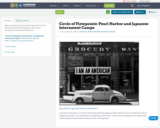
Photo of a store front the day after the attack of Pearl Harbor and Circle of Viewpoints activity as an introduction to Japanese Internment.
- Subject:
- History
- Material Type:
- Activity/Lab
- Date Added:
- 05/23/2017

Photo of a store front the day after the attack of Pearl Harbor and Circle of Viewpoints activity as an introduction to Japanese Internment.
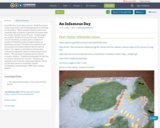
A possible way to use these sources:
* Build Ford Island using a large sheet, with battleships placed in battleship row formation.
* Write casualty statistics under each cardboard ship or airplane to generate discussion after the activity.
Possible Lesson Process:
* 5 paper planes per student
* Student sit around the map
* Primary source/eyewitness accounts given to students: A narrator of Timeline events; multiple readers for
eyewitness accounts
* Students are prompted to 'get into position' (on knees) ready for the first wave of attack.
* At a signal, in correlation to the narrative - students are signaled to throw 3 of their planes on the island.
* The narration of timeline and eye witness accounts continue.
* Students are prompted to stand up, be ready for second wave of attack.
* Students are signaled to throw the last couple paper planes.
* Wrap up with final narrative of timeline, statistic investigation, and listening to FDR's 'Day in Infamy' speech.
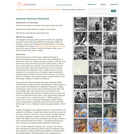
After the bombing of Pearl Harbor, President Franklin D. Roosevelt signed Executive Order 9066, which established 10 internment camps for "national security" purposes. Although most internment camps were along the West Coast, others could be found in Wyoming and Colorado, and as far east as Arkansas. One photo shows Japanese American boys in San Francisco shortly before the evacuation order; another shows a woman waiting for the evacuation bus in Hayward; approximately 660 people being evacuated by bus from San Francisco on the first day of the program; and an aerial image of people sitting on their belongings, waiting to be taken to Manzanar. The government-sponsored War Relocation Authority (WRA) hired Dorothea Lange and other photographers to take pictures of the relocation and internment of Japanese Americans. Lange?s photographs, some of which were suppressed by the WRA and only released later, often capture the irony inherent in the situation. Although internees were allowed to take only what they could carry with them to the camps, one Lange photo juxtaposes a bus poster "Such a load off my mind ? Bekins stored my things" next to a pile of internees' belongings. Another striking Lange image shows a Japanese American-owned corner store with a large "I am an American" banner hanging beneath a "Sold" sign. Another photograph of an engine's distributor, removed from a car owned by an internee, showed that people were truly prisoners at the camp, unable to drive their own cars away. Several paintings by interned Japanese American artists Henry Sugimoto and Hisako Hibi reflect their emotional experiences and give viewers a sense of what life was like for them. The paintings express the pain, suffering, and anger of those subjected to internment. Over 100,000 Japanese American men, women, and children were relocated and detained at these camps. Photographs here show people of all ages, including a grandfather and grandchild, and young children. This internment is now recognized as a violation of their human and civil rights. In 1980, the US government officially apologized and reparations were paid to survivors.
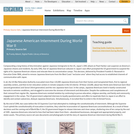
This collection uses primary sources to explore Japanese American internment during World War II. Digital Public Library of America Primary Source Sets are designed to help students develop their critical thinking skills and draw diverse material from libraries, archives, and museums across the United States. Each set includes an overview, ten to fifteen primary sources, links to related resources, and a teaching guide. These sets were created and reviewed by the teachers on the DPLA's Education Advisory Committee.
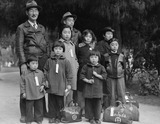
After the attack at Pearl Harbor, Japanese Americans were rounded up and sent to internment camps for the duration of World War II. This dark period was largely ignored until many years later.

After the attack at Pearl Harbor, Japanese Americans were rounded up and sent to internment camps for the duration of World War II. This dark period was largely ignored until many years later.
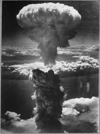
Allow your students to relive December 7, 1941 and react to the attack on Pearl Harbor. They will hear first hand accounts from survivors and experience what it was like to be there that day. Further, let them shape their own opinions about the roles Japan and the United States played in the war, and empathize with those left in the atomic aftermath.
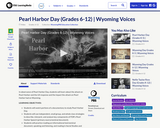
Students will learn about the attack on Pearl Harbor and the US response of the Pearl Harbor Day observance.
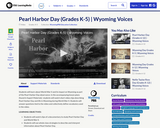
Students will learn about World War II and its impact on Wyoming as part of the Pearl Harbor Day observance.

is a detailed account of the December 7, 1941, attack. More than 100 photos and descriptions look at the 7 U.S. battleships moored along Battleship Row that morning, attacks off Ford Island, attacks in the Navy yard area, attacks on airfields, Japanese aircraft and midget submarines used in the attacks, aerial combat, and more.
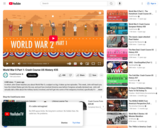
In which John Green teaches you about World War II, a subject so big, it takes up two episodes. This week, John will teach you how the United States got into the war, and just how involved America was before Congress actually declared war. John will actually talk a little about the military tactics involved, and he'll get into some of the weaponry involved, specifically the huge amount of aerial bombing that characterized the war, and the atomic bombs that ended the war in the Pacific.
Chapters:
Introduction: WWII
American Isolationism Pre-WWII
American Support for Allies in WWII
Pearl Harbor
WWII Fighting in the Pacific
WWII Fighting in Europe
Mystery Document
The End of WWII
Hiroshima, Nagasaki, & the Atomic Bomb
Credits